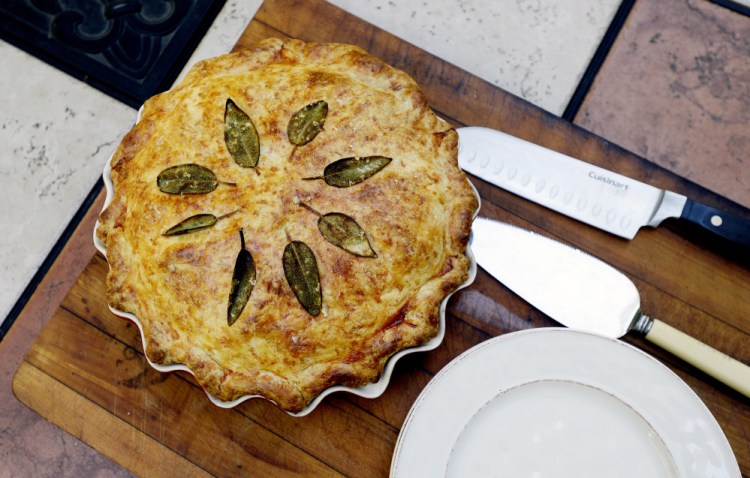My favorite part of the Common Ground Fair is preservation pomologist John Bunker’s annual Apple Tasting. You’ve got to get there early to get a seat under the tent. But as the crowd gathers at its edges, a loaves and fishes kind of thing happens: everybody gets at least a sliver of each heirloom variety on offer and a chance to hear their stories told by Maine’s own apple whisperer.
Bunker’s apple joy is contagious. I just joined his cooperative Out on a Limb heirloom apple CSA through which, for $150, I will get a quarter bushel of rare, Maine apples (10 to 12 pounds) sourced from multiple orchards every other week through early November.
The point of the CSA is to provide a market for these old apples, which many growers don’t even bother to harvest for lack of retail interest.
“If we keep these growers happy, we hope that they will take good care of their old trees” and keep the heritage varieties alive for future generations, Bunker explained.
Cultivating biodiversity in any crop is protection from having a monolithic failure of any monocrop by pests and disease. But from a culinary standpoint, cultivating apple biodiversity means that cooks can have a wide variety of apple tastes, textures, tannin levels and times at which the apples ripen.
In all, I’ll get to sample over 20 varieties I could never find in the grocery store and might only see at a farm stand once in a blue moon. I will receive a mix of eating and culinary apples.
Uh-oh. How do I know how any of these apples will behave in the pan? I went looking for a few rules for fitting apple varieties I don’t know into recipes I do.
Yankee Magazine Food Editor Amy Traverso, author of “The Apple Lover’s Cookbook,” divides all cooking apple types into four categories. Firm-tart ones like Granny Smith, Gravenstein and Ida Red hold their shape when cooked, are best for cakes and pie and benefit recipes that require “a bit of acidity and bright flavor.” Firm-sweet apples like Golden Delicious, Braeburn, Ginger Gold, Honeycrisp and Jonagold work well in savory and sweet dishes that need firm, but sweet fruit. Tender-tart apples like Cortland, Macoun or McIntosh are best for soups and sauces. And lastly, tender-sweet Gala and Fuji apples suit quick-cooking dishes, dessert sauces and especially salads since neither tends to brown very quickly when sliced.
These apples are familiar because they (plus the ubiquitous Red Delicious) are the dozen best-selling in the United States. Traverso offers up a cheat sheet for how 48 more interesting but less common culinary apples (her favorites are the firm-tart Calville Blanc and firm-sweet Pink Lady, both of which are good options for her Pork and Apple Pie with Cheddar-Sage Crust, recipe below), line up in her categories as well.
Of the 123 apple varieties Rowan Jacobsen profiles in his book “Apples of Uncommon Character,” he only enthusiastically recommends about 40 for cooking. He says early summer apples should be eaten as the first raw tastes of apple season; that dessert apples (in the English sense of fruit being served for dessert) should also be eaten straight up; and that the bulk of what he calls keepers, should be taken fresh from the root cellar as a necessary dose of freshness in winter.
I cross-checked Jacobsen’s list with Traverso’s, looking for agreement on heirloom cooking apples and found only a baker’s dozen in common. Both authors agree that Arkansas Black, Ashmead Kernel, Bramley’s Seedling, Calville Blanc, Newtown Pippin, Northern Spy, Rhode Island Greening, Rome, Roxbury Russet and Staymen Winesap apples would make great stand-ins for ordinary firm-tart Granny Smiths in cakes and pies. And they agree that Black Oxfords and Grimes Goldens can be used anywhere a recipe calls for a Braeburn. The Black Twig is the only one they agree upon as a tender-tart apple good for soups and sauces.
Understanding where the rest of the thousands of apples that grow in this region fall into your own recipes requires case-by-case research. The website maintained by Fedco Trees, an outgrowth of Fedco Seeds that is headed by Bunker, serves up an interactive chart (fedcoseeds.com/trees/apple_chart.htm) depicting over 90 types of Maine apples, their flavor profiles, their best culinary uses and their seasonality.
Still, as the saying goes, there is no accounting for personal taste. So as you’re digesting virtual information about a new-to-you apple, take a bite out of the real thing to really understand how it might fit into your own favorite apple recipes moving forward.
Christine Burns Rudalevige is a food writer, a recipe developer and tester, and a cooking teacher in Brunswick. Contact her at: cburn1227@gmail.com.
Send questions/comments to the editors.



Success. Please wait for the page to reload. If the page does not reload within 5 seconds, please refresh the page.
Enter your email and password to access comments.
Hi, to comment on stories you must . This profile is in addition to your subscription and website login.
Already have a commenting profile? .
Invalid username/password.
Please check your email to confirm and complete your registration.
Only subscribers are eligible to post comments. Please subscribe or login first for digital access. Here’s why.
Use the form below to reset your password. When you've submitted your account email, we will send an email with a reset code.